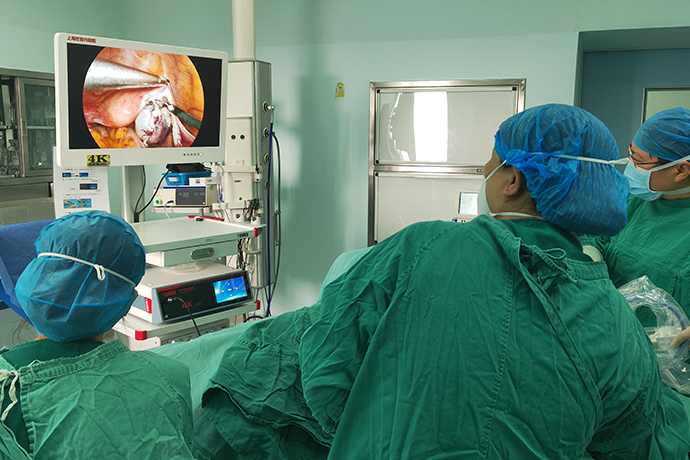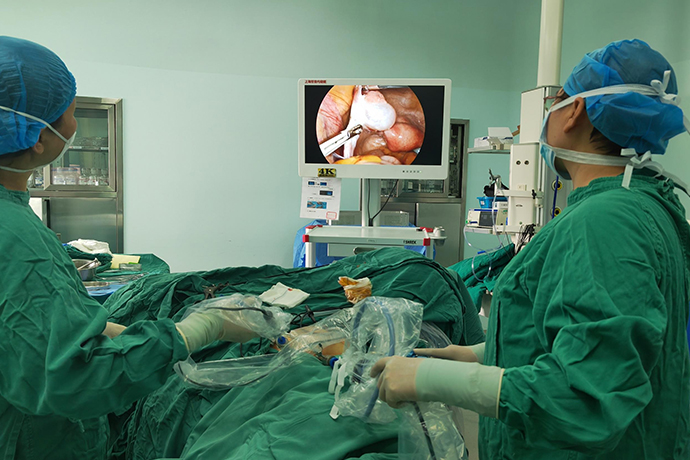[Gynecological Laparoscopy] 4K Laparoscopy for the Treatment of Endometriosis
Release time: 06 Sep 2023 Author:Shrek
What is endometriosis?
Endometriosis, referred to as endometriosis, as the name suggests, is that endometrial tissue (glands and stroma) with growth function appears in the uterine cavity covering the endometrium and the myometrium. It is the most common gynecological disease. One of the diseases.

At what age does a person get this disease?
In recent years, the incidence of this disease has been on the rise. It mainly occurs in women during the childbearing period. The most common age range is 25 to 45 years old. 25% to 35% of infertile patients develop endometriosis during laparoscopy.
What are the symptoms of this disease?
Different lesions have different symptoms, and 20% to 25% of patients have no clinical symptoms. Pain is the main symptom of endometriosis, and the progressive worsening of secondary dysmenorrhea is a typical symptom of endometriosis; the incidence of infertility is as high as 40% to 50% among patients with endometriosis; abnormal menstruation The incidence rate is 15% to 30%, and the main manifestations are increased menstrual flow, prolonged menstrual period or premenstrual spotting; discomfort during sexual intercourse, which is most obvious in the premenstrual period. If you have the above symptoms, you must go to the hospital in time for early detection.
How to treat it?
Treatment often develops individualized plans based on age, symptoms, location, fertility requirements, and previous treatment experience to achieve the purpose of reducing or removing lesions, reducing or eliminating pain, promoting fertility, and reducing recurrence. For those whose main manifestation is pelvic mass and adnexal mass ≥4cm, surgical treatment is the first choice; for those whose main manifestation is dysmenorrhea without pelvic mass and infertility, medical treatment is the first choice; for those whose main manifestation is infertility, infertility examination should be performed And fertility assessment, give patients fertility guidance.
4K laparoscopy is the first choice for treating endometriosis
The incidence rate of endometriosis is relatively high. The Chinese Medical Association has established a national endometriosis assistance group and just launched new diagnosis and treatment guidelines in March 2015. Laparoscopic examination and surgery are still regarded as the gold standard for the diagnosis and treatment of endometriosis. Under 4K laparoscopy, when the typical endometriosis lesions can be clearly observed, the diagnosis can be confirmed and the lesion can be removed at the same time. In the past, it was difficult to completely remove the intracystic fluid or separate the adhesions during laparotomy. 4K laparoscopic technology can solve these problems at the same time. Not only can the lesions be removed quickly, but also the normal structure of the pelvic cavity can be restored, the chances of the patient's conception can be increased, and the pain can be relieved. Therefore, 4K laparoscopy is the first choice for the treatment of endometriosis.
Endometriosis is a complex disease that can cause severe anatomical distortion. It is multicentric and can affect the anterior and posterior compartments of the pelvis as well as the adnexa and urinary tract.
Clinicopathological types of endometriosis
Peritoneal endometriosis: surface of the pelvic cavity, abdominal peritoneum, including: red lesions (early lesions), blue lesions (typical lesions), white lesions (old lesions)
Ovarian endometriosis: Those who form cysts are called ovarian endometriosis cysts (customarily called "chocolate cysts")
Deep invasive type: refers to the infiltration depth of the lesion ≥5mm, which is common in the sacral ligament, uterorectal fossa, vaginal vault, vaginal rectal diaphragm, etc. There are two cases of vaginal rectal diaphragmatic mass invasion: one is pseudovaginorectal diaphragmatic endometriosis, that is, the lesion is located below the adhesions due to the closure of the rectal fossa; the other is true vaginal rectal diaphragmatic endometriosis, that is, the lesion is Located outside the peritoneum, within the vaginal rectal diaphragm, the uterorectal fossa has no obvious anatomical abnormalities. The observation group used tracheal intubation to perform general anesthesia on the patients and took the bladder lithotomy position. Patients with severe pelvic adhesions and infertility need to have a uterine lift device placed. A 1 cm incision was made, above or below the umbilical cord. Establish pneumoperitoneum, and take two puncture points on both sides of the lower abdomen at approximately the level of McFarland's point, with a size of about 0.5 cm for operation. Before the operation, laparoscopy is required to diagnose, observe the uterine-rectal depression, both ovaries, and fallopian tubes, then observe the pelvic peritoneal surface in a clockwise direction, and finally check the uterine bladder peritoneal depression and uterine body. If any abnormalities are observed under laparoscopy, Black, purple-blue nodular lesions, and chocolate cysts can be diagnosed as endometriosis.
Ovarian endometriosis cystectomy: all cysts formed by ovarian endometriosis should be removed. The diameter of the cyst was controlled at 5 cm, and the ovary was sutured with 3-0 absorbable sutures to help the anatomical structure return to normal. If the diameter of the cyst is less than 5 cm, electrocautery should be used to stop the bleeding of the ovarian wound without suturing. Electrocoagulation method: for superficial ectopic lesions, including: peritoneum, sacral ligament, ovary, etc., monopolar or bipolar electrocoagulation or internal coagulation can be used for direct cautery. Others: If the patient has pelvic endometriosis combined with infertility, he needs to undergo tubal methylene blue fluid test for observation, and if there is distal obstruction and atresia of the fimbrial end of the fallopian tube, a salpingostomy should be performed. After the operation, the pelvic cavity should be rinsed repeatedly with 0.9% NaCI solution, and finally the pelvic cavity should be injected with low molecular weight dextran plus gentamicin solution to prevent adhesions.

- Recommended news
- 【General Surgery Laparoscopy】Cholecystectomy
- Surgery Steps of Hysteroscopy for Intrauterine Adhesion
- [Gynecological Hysteroscopy] Techniques for Preventing and Treating Complications of Hysteroscopic Surgery
- [Gynecological Hysteroscopy] Hysteroscopic Adhesiolysis
- [Gynecological Hysteroscopy] IUD Removal under Hysteroscopy